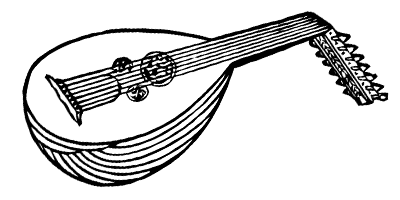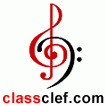Contents
01. Intro
02. History of Tab
03. Fingering
04. The Empty Bar
05. Reading a Single Note
06. Reading a Group of Notes
07. Reading Rhythm
08. Reading Rhythm with Triplets
09. Note Suspension
10. Chord Suspension
11. Other Tab Symbols
12. Final Thoughts
Intro
Tab is…
- an alternative to reading note music or score.
- a form of musical notation indicating fingering on a fretboard.
- easy to learn since it uses numbers instead of music notes.
- a lightweight portable document that can easily be created in a notepad(.txt) on any device.
- a popular form of guitar notation today.
At classclef.com, we provide both notes and tabs in pdf format.
This tutorial is for absolute beginners. I will walk you through from the very basics to a more advanced level of tabbing. By the end of this article, you will be able to read and create your own tabs.
History of Tab

Tablature or tab is derived from an earlier string instrument called the Lute. The origins of German lute tablature can be traced back well into the 15th century.
Advantage of Tab over Reading Notes
- Easy! No note sight reading knowledge required. Anyone who can recognize numbers can play.
- Exact positioning on the fingerboard. With music score, (unless clearly stated) a note can be played in multiple position on the finger board-which can be confusing.
Disadvantage of Tab over Reading Notes
- Tablature is confined to guitar. Without notes you cannot play the same piece on other instruments. Hence restrictive to a single instrument.
- Tab does not promote learning music theory. If one is totally illiterate in reading music, their potential for growth is hampered.
Fingering

The Left Hand
1 index
2 middle
3 ring
4 pinky
The left thumb in classical music is generally unused. If you play piano the above fingering can be confusing. Piano uses… 1 as thumb, 2:index, 3:middle, 4:ring, 5:pinky.
The Right hand
P pulgar or thumb
I indice or index
M medio or middle
A anular or ring
Note: The right pinky is relatively unused.
Spanish Names! Did you know The guitar was invented in Spain?
Let us Begin…
The Empty Bar
[1] e--------------------------------| B--------------------------------| G--------------------------------| D--------------------------------| A--------------------------------| E--------------------------------| | | | | | | | |
We shall begin with blank bar and then build it up. Above is a single bar or measure. Firstly, tab is read upside down. Notice the high e string (guitar string closest to the floor) is written as “e”. And the Low E (string closest to the ceiling) is written as “E”. This is a visual reminder that tab is read upside down, although not all tabs uses upper and lower case Es.
Even though there are no notes in this bar, you can determine many things…
1-The Tuning. In this case. (EGBDAE) is of a Standard Tuning.
2-The Time Signature. “|” represents the beat. 4/4. More later…
3-[1] indicates the bar number.
Please don’t confuse reading tab with reading notes off a music staff. A music staff has 5 lines. Since the guitar has 6 strings, a guitar tab reflects that and has 6. They are different! There are also other string instrument tabs like bass guitar, ukulele, and mandolin, etc…
From the letters (EBGDAE) you can determine the Tuning. This is standard tuning. There are tabs with alternate tuning such as Drop D. The tab will then be read as (EBGDAD)
Ok, now let’s put some notes in the tab!
Reading a Single Note
e--------------------------------| B--------------------------------| G--------------------------------| D--------------------------------| A--------------------------------| E-----3--------------------------| | | | | | | | | L 3 R P
Play the G note. (3rd fret Top String)
Better tabs come with R and L hand fingering (either above and below the tab). This tab says for the left hand (L) you use your 3rd finger to play the G note. For the right hand, you use your (p) thumb to pluck.
Reading a Group of Notes (played all at once)
^
e-----3-|----------------------|
B-----3-|----------------------|
G-----0-|----------------------|
D-----0-|----------------------|
A-----2-|----------------------|
E-----3-|----------------------|
| | | | | | | |
L 4
3
1
2
Whenever you see a column of numbers-stacked up on top of each other in a single line-you play all the notes together simultaneously.
This is a “G” chord. I added the arrow to illustrate the direction of strum which is from ceiling to floor. Tabs don’t normally come with the arrow. Left hand fingering is also read upside down. This tells you which finger to play each note.
Notes 0 are open strings (G and D). Tab shows 6 notes but 4 fingers? That’s because open string does not require any left finger.
Reading a Group of Notes (played one after another)
e--------------------------------| B--------------------------------| G-----------0--------------------| D---------0---0------------------| A-------2-------2----------------| E-----3-----------3--------------| | | | | | | | | L 1 2 1 2 R p i m a m i p
This is a G Arpeggio or broken chord. Notes are to be played successively one after the next. Since open strings does not require any left hand fingering, fingering for the open string (D,G) are left out. I have included the right hand finger pattern underneath each note.
pimamip…
pulgar-index-middle-anular-middle-index-pulgar.
or in english….
thumb-index-middle-ring-middle-index-thumb.
Reading Rhythm
What is a Bar?
In musical notation, a bar (or measure) is a segment of time defined by a given number of beats of a given duration. In tab, “Time” is read sideways. Better tabs come with markers “|” for Rhythm Marker.
Example 4/4
--------------Time---------------> e------3-------3-------3-------3-| B------3-------3-------3-------3-| G------0-------0-------0-------0-| D--------------------------------| A----------2---------------2-----| E--3---------------3-------------| | | | | | | | | 1 + 2 + 3 + 4 +
Above is a measure in 4/4. count 1+2+3+4+. Numbers like 1+,2+ are normally not included in tab. (We’ve got enough numbers already!) A good tabber always state what time signature at the beginning and provide “|” for reference.
Example 3/4
e-------3---------3---------3----| B-------3---------3---------3----| G-------0---------0---------0----| D--------------------------------| A------------2-------------------| E--3-------------------3---------| | | | | | | 1 + 2 + 3 +
This one is in 3/4. count 1 + 2 + 3 +
Reading Rhythm with Triplets
Now that time signature can be noted as illustrated. What about triplets? No problem! I have seen tab with “/ 3 \” before. It works and I have been using this for triplets in some of my tab ever since.
Example 2/4 with triplet. count 1 + 2 +
/ 3 \ e--------------------------3-----| B------------------3-0-3---------| G--------------------------------| D--------------------------------| A----------2---------------------| E--3-----------------------------| | | | | 1 + 2 +
Note Suspension
Holding a note (suspending) in 3/4 time signature
e-------3---------3---------3----| B-------3---------3---------3----| G-------0---------0---------0----| D----------------------0========-| A------------2=========----------| E--3=========--------------------| | | | | | | 1 + 2 + 3 +
Holding a note is notated as (=====) In this example you play and hold the bass note for a specified time.
1 + for G, 2 + for B, and finally 3 + for D.
Chord suspension
e--3========-0========-3========-| B--3========-2========-3========-| G--0========-2========-0========-| D--0========-2========-0========-| A--2========-0========-2========-| E--3========-----------3========-| | | | | | | 1 + 2 + 3 + L 4 3 4 3 2 3 1 1 1 2 2
G-A-G chord. All notes of chords are suspended. Play the chord and hold the notes.
Other Tab Symbols
e|-----|-----|-----|-----|-----|
B|-----|-----|-----|-----|-----|
G|-----|-----|-----|-----|-----|
D|-----|-----|-----|-----|-----|
A|-0h2-|-2p0-|-2b--|-4r2-|-5/7-|
E|-----|-----|-----|-----|-----|
A B C D E
PM
e|-----|-----|-----|-----|-----|
B|-----|-----|-----|-----|-----|
G|-----|-----|-----|-----|-----|
D|-----|-----|-----|-----|-----|
A|--x--|-<7>-|-[7]-|-7~--|--5--|
E|-----|-----|-----|-----|-----|
F G H I J
pizz. tr < >
e|-----|-----|-----|-----|-----|
B|-----|-----|-----|-----|-----|
G|-----|-----|-----|-----|-----|
D|-----|-----|-----|-----|-----|
A|--5--|-0101|--5--|--5--|-(3)-|
E|-----|-----|-----|-----|-----|
K L M N O
III 1/2 III
e|--3--------|--3--------|-----|
B|--3--------|--3--------|-----|
G|--4--------|--3--------|-5t--|
D|--5--------|-----------|-----|
A|--5--------|-----------|-----|
E|--3--------|-----------|-----|
P Q R
A) Hammer On: pick a note then with another finger hammer on another note on the same string. 1 pick 2 notes.
B) Pull Off: opposite of hammer on pick a note then pull off.
C) String Bend-fretting hand actually bends the string upwards. raising its pitch by half step or full step.
D) Bend Release-like a bend, but it tells you when to release the bend and go to the next note
E) Slide: play the first note on 5 then slide the finger that is holding
that note up to 7.
F) Mute: Using heel of palm dampen string
G) Harmonic (Natural) very high pitch notes impossible to reach by
fretting.
H) Harmonic (Artificial) very high pitch notes impossible to reach by
fretting. 12 fret.
I) Vibrato: musical effect consisting of a regular pulsating change of
pitch
J) Palm Mute: right heel of palm on string. use with pick strum downstairs
K) Pizzicato: right heel of thumb on bridge. pluck thumb downwards on
string
L) Trill: quick hammer on and pull offs.
M) Accent-Louder: played louder
N) Softer: played softer
O) Ghost Note: played very faintly. Ghost notes are barely audible,
but they do a lot to the feel of the music.
P) Barred Chord 3 fret (all 6 strings)
Q) Half Barred Chord (bottom 3 strings)
R) Tap the notes on the fret board with your right hand.
Final Thoughts
Tab is great but learning to read music makes you a better musician! The pdfs provided on ClassClef includes both tab and score. You can improve sight reading by using the tab as reference to compare notes and vice versa!
